UGB107 - Business Management: Analyzing Mark & Spencer with Theories
VerifiedAdded on 2022/11/29
|12
|4050
|27
Report
AI Summary
This report provides a comprehensive analysis of business management principles, applying them to the case of Mark & Spencer. It begins by defining management and exploring Mintzberg's theory of management roles, emphasizing interpersonal, informational, and decisional aspects. The report then delves into external factors impacting Mark & Spencer through a PESTLE analysis, covering political, economic, social, technological, legal, and environmental influences. Porter's Five Forces model is used to assess competitive intensity, the threat of new entrants and substitutes, and the bargaining power of customers and suppliers. Furthermore, the report discusses corporate social responsibility (CSR) practices, highlighting both positive initiatives and instances of corporate malpractice. Finally, it touches upon Hofstede's cultural dimensions, providing a holistic view of the business environment and strategic considerations for Mark & Spencer. This detailed analysis is designed to provide a thorough understanding of business management concepts in a real-world context, offering insights into strategic decision-making and organizational behavior.
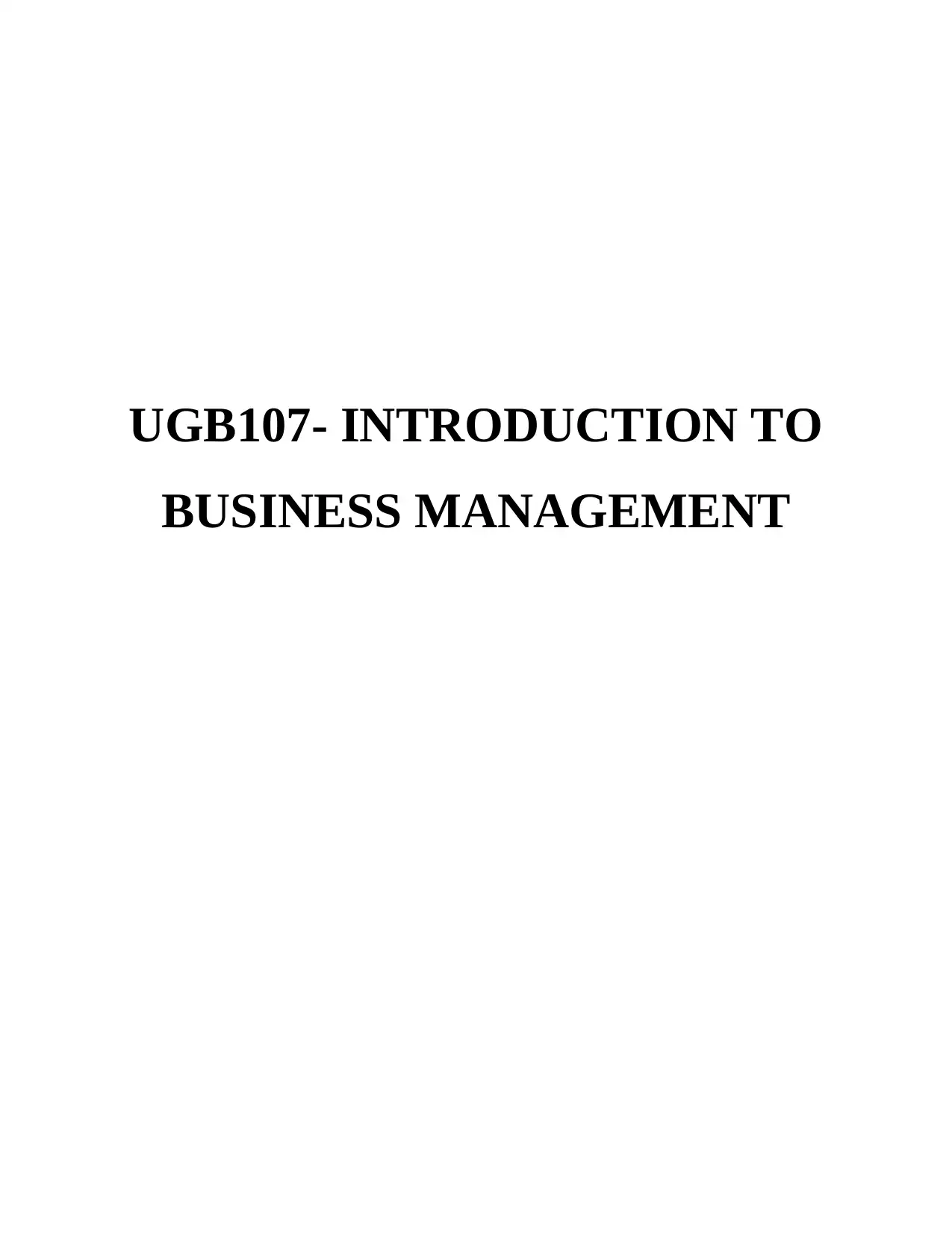
UGB107- INTRODUCTION TO
BUSINESS MANAGEMENT
BUSINESS MANAGEMENT
Paraphrase This Document
Need a fresh take? Get an instant paraphrase of this document with our AI Paraphraser
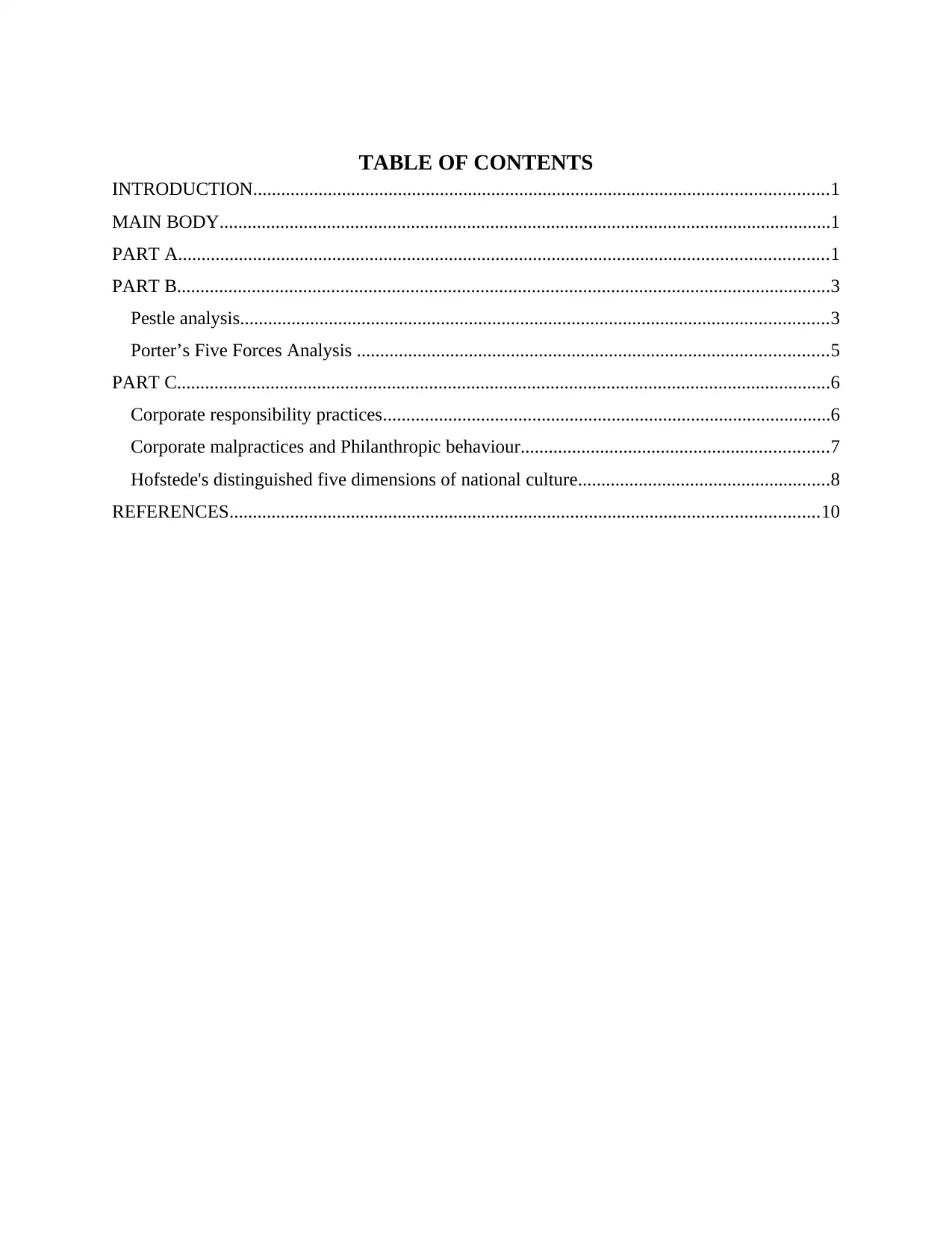
TABLE OF CONTENTS
INTRODUCTION...........................................................................................................................1
MAIN BODY...................................................................................................................................1
PART A...........................................................................................................................................1
PART B............................................................................................................................................3
Pestle analysis..............................................................................................................................3
Porter’s Five Forces Analysis .....................................................................................................5
PART C............................................................................................................................................6
Corporate responsibility practices................................................................................................6
Corporate malpractices and Philanthropic behaviour..................................................................7
Hofstede's distinguished five dimensions of national culture......................................................8
REFERENCES..............................................................................................................................10
INTRODUCTION...........................................................................................................................1
MAIN BODY...................................................................................................................................1
PART A...........................................................................................................................................1
PART B............................................................................................................................................3
Pestle analysis..............................................................................................................................3
Porter’s Five Forces Analysis .....................................................................................................5
PART C............................................................................................................................................6
Corporate responsibility practices................................................................................................6
Corporate malpractices and Philanthropic behaviour..................................................................7
Hofstede's distinguished five dimensions of national culture......................................................8
REFERENCES..............................................................................................................................10
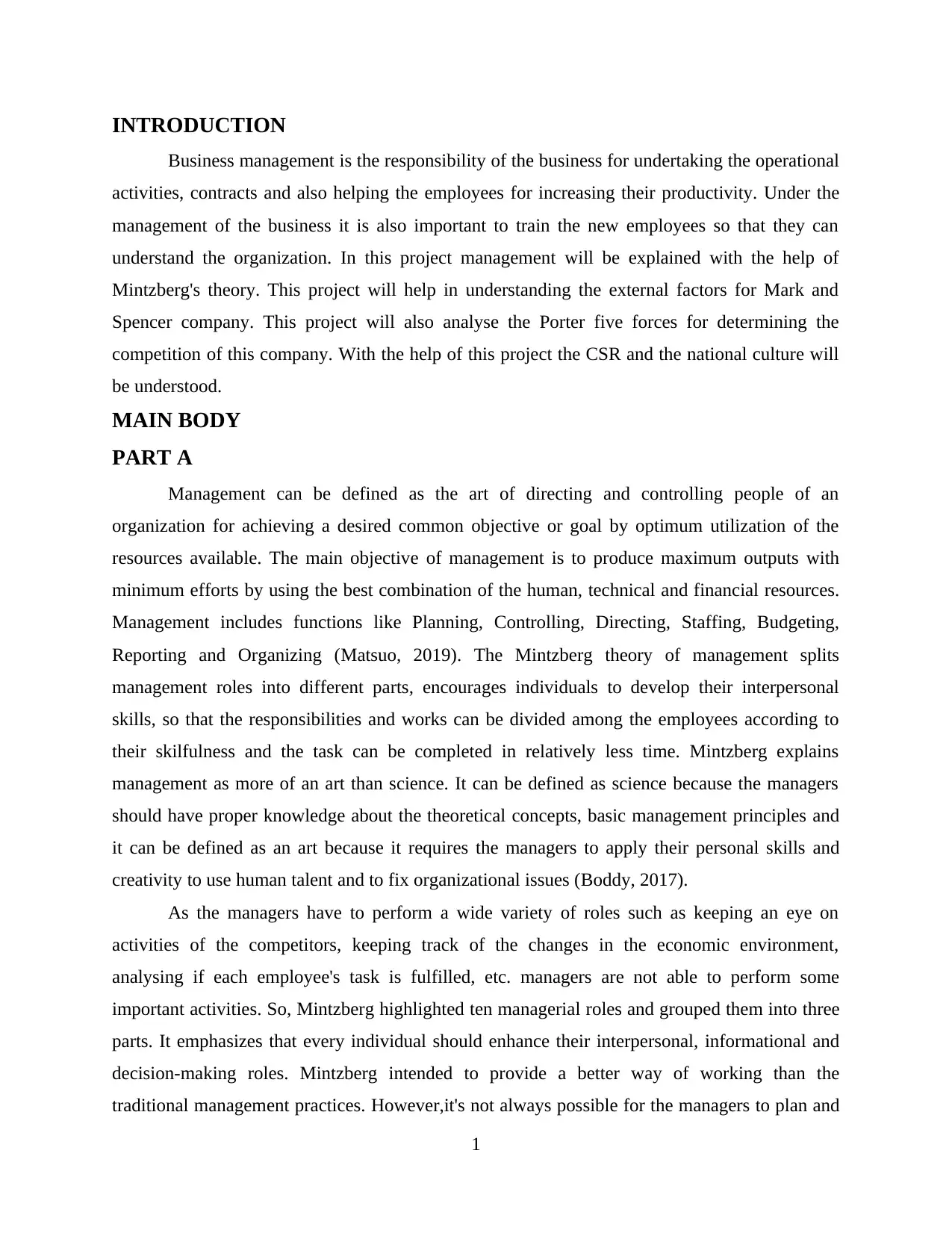
INTRODUCTION
Business management is the responsibility of the business for undertaking the operational
activities, contracts and also helping the employees for increasing their productivity. Under the
management of the business it is also important to train the new employees so that they can
understand the organization. In this project management will be explained with the help of
Mintzberg's theory. This project will help in understanding the external factors for Mark and
Spencer company. This project will also analyse the Porter five forces for determining the
competition of this company. With the help of this project the CSR and the national culture will
be understood.
MAIN BODY
PART A
Management can be defined as the art of directing and controlling people of an
organization for achieving a desired common objective or goal by optimum utilization of the
resources available. The main objective of management is to produce maximum outputs with
minimum efforts by using the best combination of the human, technical and financial resources.
Management includes functions like Planning, Controlling, Directing, Staffing, Budgeting,
Reporting and Organizing (Matsuo, 2019). The Mintzberg theory of management splits
management roles into different parts, encourages individuals to develop their interpersonal
skills, so that the responsibilities and works can be divided among the employees according to
their skilfulness and the task can be completed in relatively less time. Mintzberg explains
management as more of an art than science. It can be defined as science because the managers
should have proper knowledge about the theoretical concepts, basic management principles and
it can be defined as an art because it requires the managers to apply their personal skills and
creativity to use human talent and to fix organizational issues (Boddy, 2017).
As the managers have to perform a wide variety of roles such as keeping an eye on
activities of the competitors, keeping track of the changes in the economic environment,
analysing if each employee's task is fulfilled, etc. managers are not able to perform some
important activities. So, Mintzberg highlighted ten managerial roles and grouped them into three
parts. It emphasizes that every individual should enhance their interpersonal, informational and
decision-making roles. Mintzberg intended to provide a better way of working than the
traditional management practices. However,it's not always possible for the managers to plan and
1
Business management is the responsibility of the business for undertaking the operational
activities, contracts and also helping the employees for increasing their productivity. Under the
management of the business it is also important to train the new employees so that they can
understand the organization. In this project management will be explained with the help of
Mintzberg's theory. This project will help in understanding the external factors for Mark and
Spencer company. This project will also analyse the Porter five forces for determining the
competition of this company. With the help of this project the CSR and the national culture will
be understood.
MAIN BODY
PART A
Management can be defined as the art of directing and controlling people of an
organization for achieving a desired common objective or goal by optimum utilization of the
resources available. The main objective of management is to produce maximum outputs with
minimum efforts by using the best combination of the human, technical and financial resources.
Management includes functions like Planning, Controlling, Directing, Staffing, Budgeting,
Reporting and Organizing (Matsuo, 2019). The Mintzberg theory of management splits
management roles into different parts, encourages individuals to develop their interpersonal
skills, so that the responsibilities and works can be divided among the employees according to
their skilfulness and the task can be completed in relatively less time. Mintzberg explains
management as more of an art than science. It can be defined as science because the managers
should have proper knowledge about the theoretical concepts, basic management principles and
it can be defined as an art because it requires the managers to apply their personal skills and
creativity to use human talent and to fix organizational issues (Boddy, 2017).
As the managers have to perform a wide variety of roles such as keeping an eye on
activities of the competitors, keeping track of the changes in the economic environment,
analysing if each employee's task is fulfilled, etc. managers are not able to perform some
important activities. So, Mintzberg highlighted ten managerial roles and grouped them into three
parts. It emphasizes that every individual should enhance their interpersonal, informational and
decision-making roles. Mintzberg intended to provide a better way of working than the
traditional management practices. However,it's not always possible for the managers to plan and
1
⊘ This is a preview!⊘
Do you want full access?
Subscribe today to unlock all pages.

Trusted by 1+ million students worldwide
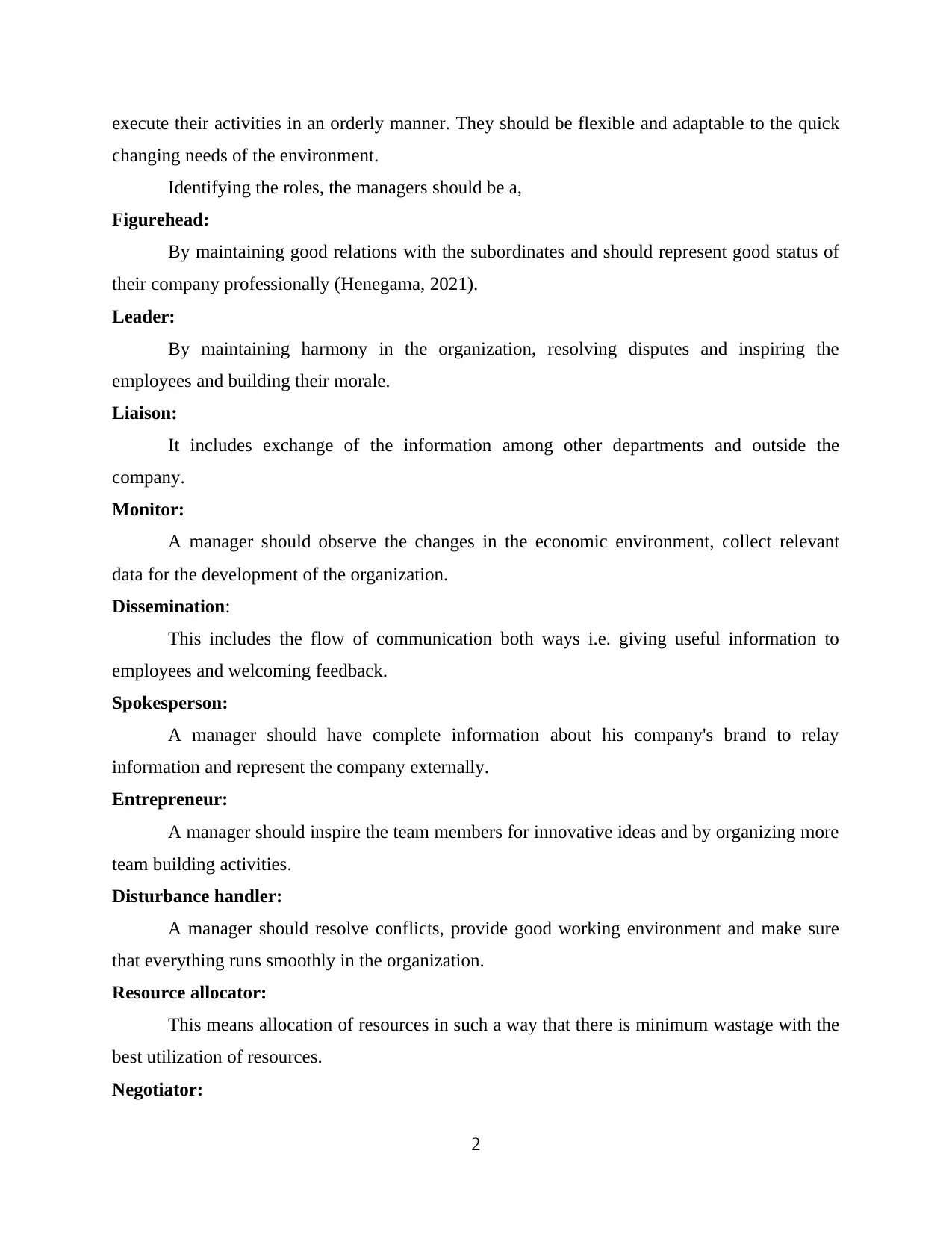
execute their activities in an orderly manner. They should be flexible and adaptable to the quick
changing needs of the environment.
Identifying the roles, the managers should be a,
Figurehead:
By maintaining good relations with the subordinates and should represent good status of
their company professionally (Henegama, 2021).
Leader:
By maintaining harmony in the organization, resolving disputes and inspiring the
employees and building their morale.
Liaison:
It includes exchange of the information among other departments and outside the
company.
Monitor:
A manager should observe the changes in the economic environment, collect relevant
data for the development of the organization.
Dissemination:
This includes the flow of communication both ways i.e. giving useful information to
employees and welcoming feedback.
Spokesperson:
A manager should have complete information about his company's brand to relay
information and represent the company externally.
Entrepreneur:
A manager should inspire the team members for innovative ideas and by organizing more
team building activities.
Disturbance handler:
A manager should resolve conflicts, provide good working environment and make sure
that everything runs smoothly in the organization.
Resource allocator:
This means allocation of resources in such a way that there is minimum wastage with the
best utilization of resources.
Negotiator:
2
changing needs of the environment.
Identifying the roles, the managers should be a,
Figurehead:
By maintaining good relations with the subordinates and should represent good status of
their company professionally (Henegama, 2021).
Leader:
By maintaining harmony in the organization, resolving disputes and inspiring the
employees and building their morale.
Liaison:
It includes exchange of the information among other departments and outside the
company.
Monitor:
A manager should observe the changes in the economic environment, collect relevant
data for the development of the organization.
Dissemination:
This includes the flow of communication both ways i.e. giving useful information to
employees and welcoming feedback.
Spokesperson:
A manager should have complete information about his company's brand to relay
information and represent the company externally.
Entrepreneur:
A manager should inspire the team members for innovative ideas and by organizing more
team building activities.
Disturbance handler:
A manager should resolve conflicts, provide good working environment and make sure
that everything runs smoothly in the organization.
Resource allocator:
This means allocation of resources in such a way that there is minimum wastage with the
best utilization of resources.
Negotiator:
2
Paraphrase This Document
Need a fresh take? Get an instant paraphrase of this document with our AI Paraphraser
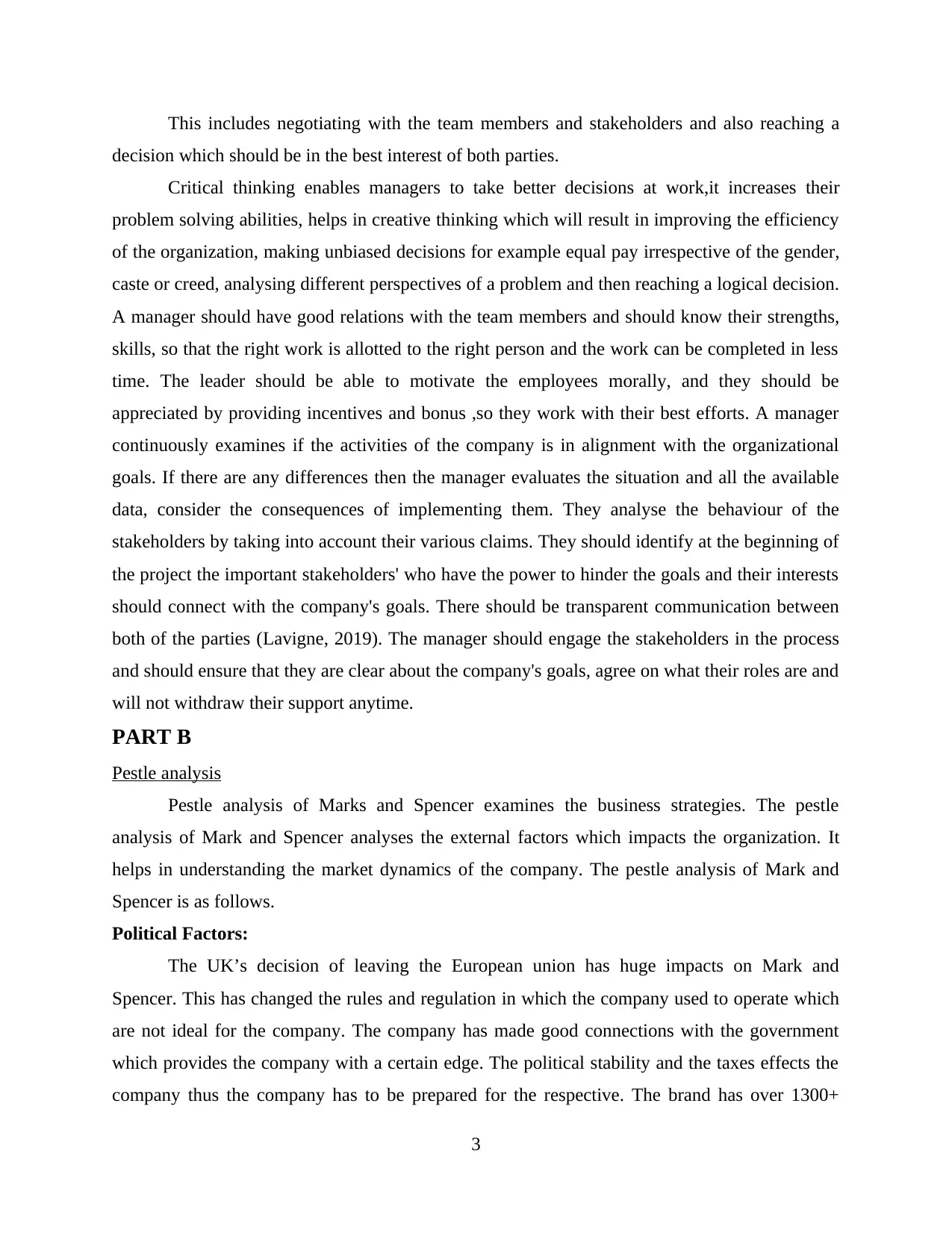
This includes negotiating with the team members and stakeholders and also reaching a
decision which should be in the best interest of both parties.
Critical thinking enables managers to take better decisions at work,it increases their
problem solving abilities, helps in creative thinking which will result in improving the efficiency
of the organization, making unbiased decisions for example equal pay irrespective of the gender,
caste or creed, analysing different perspectives of a problem and then reaching a logical decision.
A manager should have good relations with the team members and should know their strengths,
skills, so that the right work is allotted to the right person and the work can be completed in less
time. The leader should be able to motivate the employees morally, and they should be
appreciated by providing incentives and bonus ,so they work with their best efforts. A manager
continuously examines if the activities of the company is in alignment with the organizational
goals. If there are any differences then the manager evaluates the situation and all the available
data, consider the consequences of implementing them. They analyse the behaviour of the
stakeholders by taking into account their various claims. They should identify at the beginning of
the project the important stakeholders' who have the power to hinder the goals and their interests
should connect with the company's goals. There should be transparent communication between
both of the parties (Lavigne, 2019). The manager should engage the stakeholders in the process
and should ensure that they are clear about the company's goals, agree on what their roles are and
will not withdraw their support anytime.
PART B
Pestle analysis
Pestle analysis of Marks and Spencer examines the business strategies. The pestle
analysis of Mark and Spencer analyses the external factors which impacts the organization. It
helps in understanding the market dynamics of the company. The pestle analysis of Mark and
Spencer is as follows.
Political Factors:
The UK’s decision of leaving the European union has huge impacts on Mark and
Spencer. This has changed the rules and regulation in which the company used to operate which
are not ideal for the company. The company has made good connections with the government
which provides the company with a certain edge. The political stability and the taxes effects the
company thus the company has to be prepared for the respective. The brand has over 1300+
3
decision which should be in the best interest of both parties.
Critical thinking enables managers to take better decisions at work,it increases their
problem solving abilities, helps in creative thinking which will result in improving the efficiency
of the organization, making unbiased decisions for example equal pay irrespective of the gender,
caste or creed, analysing different perspectives of a problem and then reaching a logical decision.
A manager should have good relations with the team members and should know their strengths,
skills, so that the right work is allotted to the right person and the work can be completed in less
time. The leader should be able to motivate the employees morally, and they should be
appreciated by providing incentives and bonus ,so they work with their best efforts. A manager
continuously examines if the activities of the company is in alignment with the organizational
goals. If there are any differences then the manager evaluates the situation and all the available
data, consider the consequences of implementing them. They analyse the behaviour of the
stakeholders by taking into account their various claims. They should identify at the beginning of
the project the important stakeholders' who have the power to hinder the goals and their interests
should connect with the company's goals. There should be transparent communication between
both of the parties (Lavigne, 2019). The manager should engage the stakeholders in the process
and should ensure that they are clear about the company's goals, agree on what their roles are and
will not withdraw their support anytime.
PART B
Pestle analysis
Pestle analysis of Marks and Spencer examines the business strategies. The pestle
analysis of Mark and Spencer analyses the external factors which impacts the organization. It
helps in understanding the market dynamics of the company. The pestle analysis of Mark and
Spencer is as follows.
Political Factors:
The UK’s decision of leaving the European union has huge impacts on Mark and
Spencer. This has changed the rules and regulation in which the company used to operate which
are not ideal for the company. The company has made good connections with the government
which provides the company with a certain edge. The political stability and the taxes effects the
company thus the company has to be prepared for the respective. The brand has over 1300+
3

stores all over the world giving the company area to improve and a diverse political conditions of
each country they operate in.
Economic Factors:
The UK’s decision of leaving the European union has led to the country to experience
high inflation rates. The economic factors include high interest rates, foreign exchange rates and
many more. This led to the decrease in the total demand of the market, thus effecting the market
of the company. The company withdrew its initial idea of offering discount of upto 20% to the
customers which resulted in high prices of the products. Overall the company’s intention is to
provide good quality products to the customers. The company had to make job cuts around 2 %
also to tackle this situation.
Social Factors:
The company has always been doing and providing ofr the society and doing various
social campaigns and making goodwill amongst the society. The company saw that the cheap
clothing industry was starting to grow and was providing low quality with low prices. The
change in the societies preferences and the change in the trends led to the negative impact on the
company. The company implemented some new strategies to tackle these situations as they
started to accept new payment methods which started to attract new customers. The increase in
the trade was up to 10% (Orlov and Chubarkina, 2017).
Technological Factors:
Mark and Spencer adopted a new technology named Technology Transformation
Programme. This programme enables the company to deliver its product to a much diverse
customer experience. It has created a much more agile, fast and efficient function of the
company which has impacted the company in a positive way increasing its growth rate. The
company has tuned its focus on the simplification and consolidation of the suppliers and
adoption f new technologies which would improve the company’s productivity. The company
acknowledged the importance of technology in today’s world hence creating better products and
a better customer based products.
Legal Factors:
The legal constitutes of countries are changing every now and then. The company has
always focused on revising these laws and regulations by conducting certain sessions which had
been better for creating legal awareness. The company however was accused of not paying
4
each country they operate in.
Economic Factors:
The UK’s decision of leaving the European union has led to the country to experience
high inflation rates. The economic factors include high interest rates, foreign exchange rates and
many more. This led to the decrease in the total demand of the market, thus effecting the market
of the company. The company withdrew its initial idea of offering discount of upto 20% to the
customers which resulted in high prices of the products. Overall the company’s intention is to
provide good quality products to the customers. The company had to make job cuts around 2 %
also to tackle this situation.
Social Factors:
The company has always been doing and providing ofr the society and doing various
social campaigns and making goodwill amongst the society. The company saw that the cheap
clothing industry was starting to grow and was providing low quality with low prices. The
change in the societies preferences and the change in the trends led to the negative impact on the
company. The company implemented some new strategies to tackle these situations as they
started to accept new payment methods which started to attract new customers. The increase in
the trade was up to 10% (Orlov and Chubarkina, 2017).
Technological Factors:
Mark and Spencer adopted a new technology named Technology Transformation
Programme. This programme enables the company to deliver its product to a much diverse
customer experience. It has created a much more agile, fast and efficient function of the
company which has impacted the company in a positive way increasing its growth rate. The
company has tuned its focus on the simplification and consolidation of the suppliers and
adoption f new technologies which would improve the company’s productivity. The company
acknowledged the importance of technology in today’s world hence creating better products and
a better customer based products.
Legal Factors:
The legal constitutes of countries are changing every now and then. The company has
always focused on revising these laws and regulations by conducting certain sessions which had
been better for creating legal awareness. The company however was accused of not paying
4
⊘ This is a preview!⊘
Do you want full access?
Subscribe today to unlock all pages.

Trusted by 1+ million students worldwide
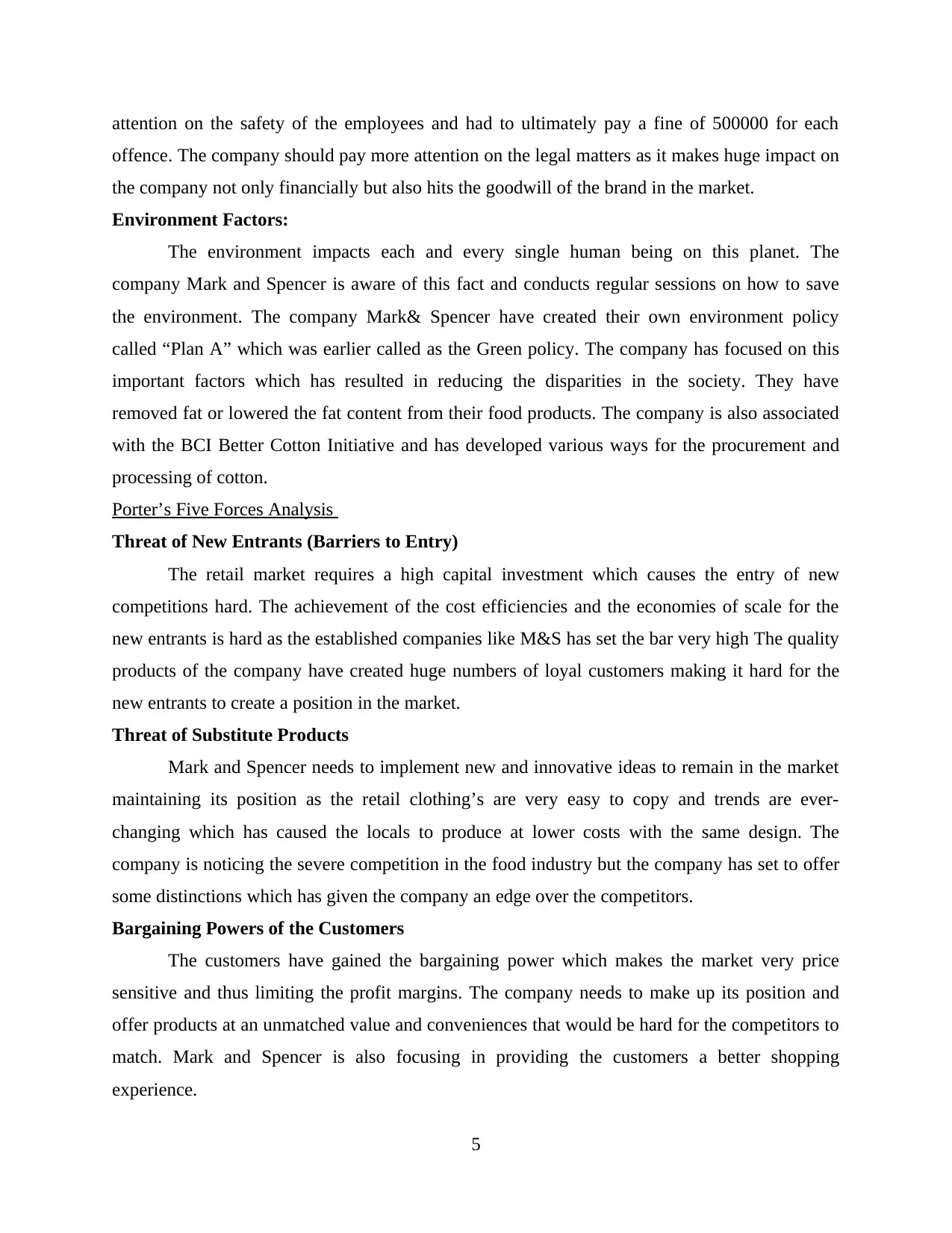
attention on the safety of the employees and had to ultimately pay a fine of 500000 for each
offence. The company should pay more attention on the legal matters as it makes huge impact on
the company not only financially but also hits the goodwill of the brand in the market.
Environment Factors:
The environment impacts each and every single human being on this planet. The
company Mark and Spencer is aware of this fact and conducts regular sessions on how to save
the environment. The company Mark& Spencer have created their own environment policy
called “Plan A” which was earlier called as the Green policy. The company has focused on this
important factors which has resulted in reducing the disparities in the society. They have
removed fat or lowered the fat content from their food products. The company is also associated
with the BCI Better Cotton Initiative and has developed various ways for the procurement and
processing of cotton.
Porter’s Five Forces Analysis
Threat of New Entrants (Barriers to Entry)
The retail market requires a high capital investment which causes the entry of new
competitions hard. The achievement of the cost efficiencies and the economies of scale for the
new entrants is hard as the established companies like M&S has set the bar very high The quality
products of the company have created huge numbers of loyal customers making it hard for the
new entrants to create a position in the market.
Threat of Substitute Products
Mark and Spencer needs to implement new and innovative ideas to remain in the market
maintaining its position as the retail clothing’s are very easy to copy and trends are ever-
changing which has caused the locals to produce at lower costs with the same design. The
company is noticing the severe competition in the food industry but the company has set to offer
some distinctions which has given the company an edge over the competitors.
Bargaining Powers of the Customers
The customers have gained the bargaining power which makes the market very price
sensitive and thus limiting the profit margins. The company needs to make up its position and
offer products at an unmatched value and conveniences that would be hard for the competitors to
match. Mark and Spencer is also focusing in providing the customers a better shopping
experience.
5
offence. The company should pay more attention on the legal matters as it makes huge impact on
the company not only financially but also hits the goodwill of the brand in the market.
Environment Factors:
The environment impacts each and every single human being on this planet. The
company Mark and Spencer is aware of this fact and conducts regular sessions on how to save
the environment. The company Mark& Spencer have created their own environment policy
called “Plan A” which was earlier called as the Green policy. The company has focused on this
important factors which has resulted in reducing the disparities in the society. They have
removed fat or lowered the fat content from their food products. The company is also associated
with the BCI Better Cotton Initiative and has developed various ways for the procurement and
processing of cotton.
Porter’s Five Forces Analysis
Threat of New Entrants (Barriers to Entry)
The retail market requires a high capital investment which causes the entry of new
competitions hard. The achievement of the cost efficiencies and the economies of scale for the
new entrants is hard as the established companies like M&S has set the bar very high The quality
products of the company have created huge numbers of loyal customers making it hard for the
new entrants to create a position in the market.
Threat of Substitute Products
Mark and Spencer needs to implement new and innovative ideas to remain in the market
maintaining its position as the retail clothing’s are very easy to copy and trends are ever-
changing which has caused the locals to produce at lower costs with the same design. The
company is noticing the severe competition in the food industry but the company has set to offer
some distinctions which has given the company an edge over the competitors.
Bargaining Powers of the Customers
The customers have gained the bargaining power which makes the market very price
sensitive and thus limiting the profit margins. The company needs to make up its position and
offer products at an unmatched value and conveniences that would be hard for the competitors to
match. Mark and Spencer is also focusing in providing the customers a better shopping
experience.
5
Paraphrase This Document
Need a fresh take? Get an instant paraphrase of this document with our AI Paraphraser
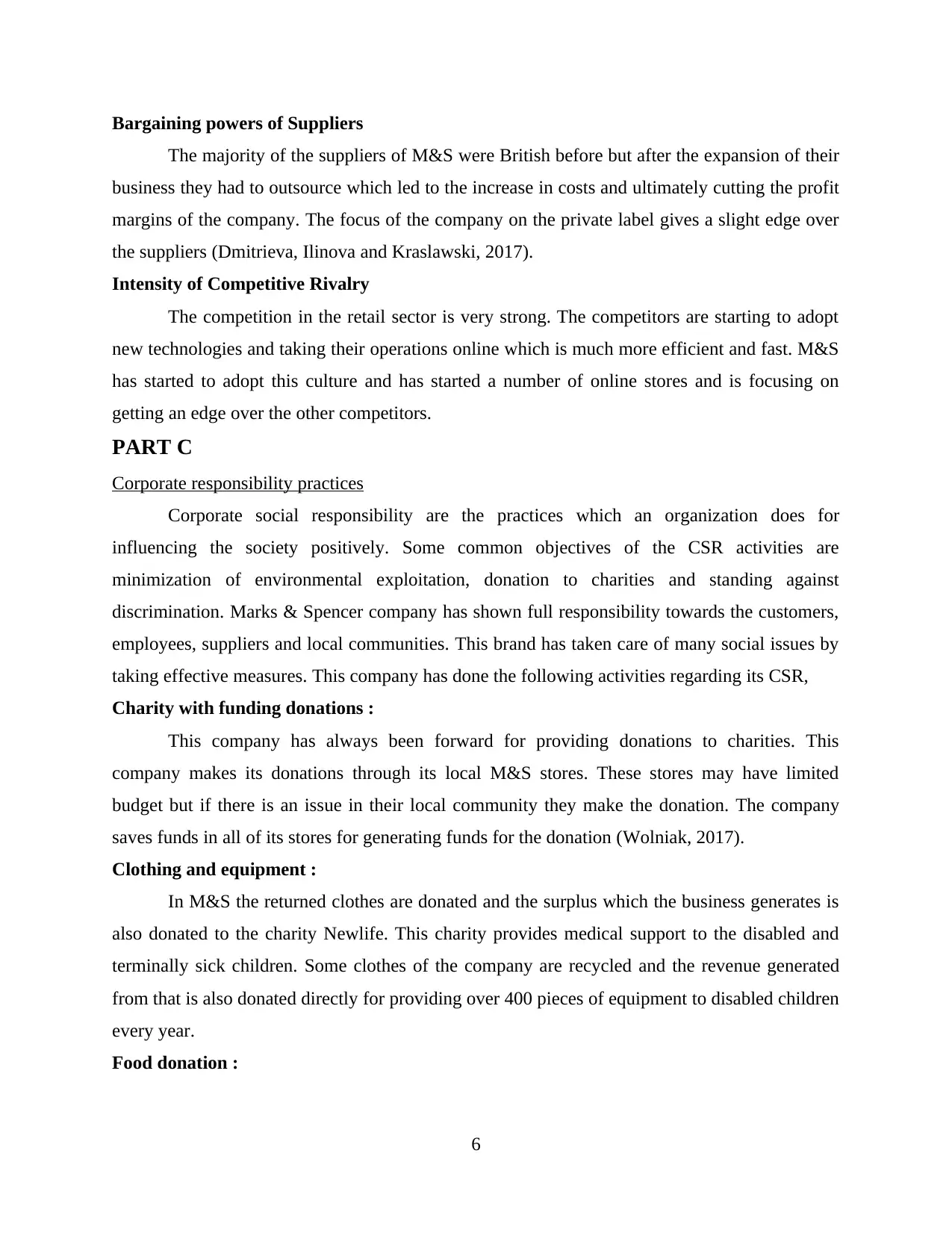
Bargaining powers of Suppliers
The majority of the suppliers of M&S were British before but after the expansion of their
business they had to outsource which led to the increase in costs and ultimately cutting the profit
margins of the company. The focus of the company on the private label gives a slight edge over
the suppliers (Dmitrieva, Ilinova and Kraslawski, 2017).
Intensity of Competitive Rivalry
The competition in the retail sector is very strong. The competitors are starting to adopt
new technologies and taking their operations online which is much more efficient and fast. M&S
has started to adopt this culture and has started a number of online stores and is focusing on
getting an edge over the other competitors.
PART C
Corporate responsibility practices
Corporate social responsibility are the practices which an organization does for
influencing the society positively. Some common objectives of the CSR activities are
minimization of environmental exploitation, donation to charities and standing against
discrimination. Marks & Spencer company has shown full responsibility towards the customers,
employees, suppliers and local communities. This brand has taken care of many social issues by
taking effective measures. This company has done the following activities regarding its CSR,
Charity with funding donations :
This company has always been forward for providing donations to charities. This
company makes its donations through its local M&S stores. These stores may have limited
budget but if there is an issue in their local community they make the donation. The company
saves funds in all of its stores for generating funds for the donation (Wolniak, 2017).
Clothing and equipment :
In M&S the returned clothes are donated and the surplus which the business generates is
also donated to the charity Newlife. This charity provides medical support to the disabled and
terminally sick children. Some clothes of the company are recycled and the revenue generated
from that is also donated directly for providing over 400 pieces of equipment to disabled children
every year.
Food donation :
6
The majority of the suppliers of M&S were British before but after the expansion of their
business they had to outsource which led to the increase in costs and ultimately cutting the profit
margins of the company. The focus of the company on the private label gives a slight edge over
the suppliers (Dmitrieva, Ilinova and Kraslawski, 2017).
Intensity of Competitive Rivalry
The competition in the retail sector is very strong. The competitors are starting to adopt
new technologies and taking their operations online which is much more efficient and fast. M&S
has started to adopt this culture and has started a number of online stores and is focusing on
getting an edge over the other competitors.
PART C
Corporate responsibility practices
Corporate social responsibility are the practices which an organization does for
influencing the society positively. Some common objectives of the CSR activities are
minimization of environmental exploitation, donation to charities and standing against
discrimination. Marks & Spencer company has shown full responsibility towards the customers,
employees, suppliers and local communities. This brand has taken care of many social issues by
taking effective measures. This company has done the following activities regarding its CSR,
Charity with funding donations :
This company has always been forward for providing donations to charities. This
company makes its donations through its local M&S stores. These stores may have limited
budget but if there is an issue in their local community they make the donation. The company
saves funds in all of its stores for generating funds for the donation (Wolniak, 2017).
Clothing and equipment :
In M&S the returned clothes are donated and the surplus which the business generates is
also donated to the charity Newlife. This charity provides medical support to the disabled and
terminally sick children. Some clothes of the company are recycled and the revenue generated
from that is also donated directly for providing over 400 pieces of equipment to disabled children
every year.
Food donation :
6

This company is known to donate the date-expired food to charity. To a charity named
Fare Share which distributes the surplus food of from companies in UK to the vulnerable people.
Climate :
The aim of this company has been to help the customers and the supplies to reduce the
emission caused in the operational process. The plan of the company is to reduce the energy
usage by 25% and promote more and more usage of green electricity for decreasing the CO2
omission. This company has also launched information campaigns for their customers and
employees regarding their collaboration with different institutes such as WWF, The Climate
Group and National Federation of Women's Institutes (Terrero-De La Rosa and et.al., 2017).
Waste Management :
M&S has stopped sending the waste it produces to the landfill in UK and the company
has also stopped using plastic bags for packaging. This company is planned for utilizing the total
food wasted for production of green energy and for production of biodegradable packaging
material.
These are some activities which this company does for Corporate Social Responsibility,
there are also some other things on which the company focuses on as their Corporate
Responsibility such as, Health and safety of their employees, Recruitment of new employees, Job
security of the existing employees and also training and development (Kang and Sivadas, 2018).
Corporate malpractices and Philanthropic behaviour
The Corporate malpractices are the illegal actions taken by an organization or an
individual which is trusted by the society (Sadler, 2020). Thus, it can be said that the corporate
malpractice are a type of fraud. These can unethical actions and behaviour which should not be
practiced. Some examples of Corporate malpractices are,
Volkswagen :
Volkswagen is one of the most famous car manufacturing company in the world. This
company is based in German however, Its business is spread all across the world in many
countries including UK. It is hard to believe that a company of this calibre can be part of
Corporate malpractices. This company was accused of rigging of the products in order to pass
the quality tests of its cars. This company was found cheating in the pollution emission test
which determined the level of pollution caused from the gases emitted from the car. For passing
the test by cheating this company decided to cheat with the stationary test rig. This is a corporate
7
Fare Share which distributes the surplus food of from companies in UK to the vulnerable people.
Climate :
The aim of this company has been to help the customers and the supplies to reduce the
emission caused in the operational process. The plan of the company is to reduce the energy
usage by 25% and promote more and more usage of green electricity for decreasing the CO2
omission. This company has also launched information campaigns for their customers and
employees regarding their collaboration with different institutes such as WWF, The Climate
Group and National Federation of Women's Institutes (Terrero-De La Rosa and et.al., 2017).
Waste Management :
M&S has stopped sending the waste it produces to the landfill in UK and the company
has also stopped using plastic bags for packaging. This company is planned for utilizing the total
food wasted for production of green energy and for production of biodegradable packaging
material.
These are some activities which this company does for Corporate Social Responsibility,
there are also some other things on which the company focuses on as their Corporate
Responsibility such as, Health and safety of their employees, Recruitment of new employees, Job
security of the existing employees and also training and development (Kang and Sivadas, 2018).
Corporate malpractices and Philanthropic behaviour
The Corporate malpractices are the illegal actions taken by an organization or an
individual which is trusted by the society (Sadler, 2020). Thus, it can be said that the corporate
malpractice are a type of fraud. These can unethical actions and behaviour which should not be
practiced. Some examples of Corporate malpractices are,
Volkswagen :
Volkswagen is one of the most famous car manufacturing company in the world. This
company is based in German however, Its business is spread all across the world in many
countries including UK. It is hard to believe that a company of this calibre can be part of
Corporate malpractices. This company was accused of rigging of the products in order to pass
the quality tests of its cars. This company was found cheating in the pollution emission test
which determined the level of pollution caused from the gases emitted from the car. For passing
the test by cheating this company decided to cheat with the stationary test rig. This is a corporate
7
⊘ This is a preview!⊘
Do you want full access?
Subscribe today to unlock all pages.

Trusted by 1+ million students worldwide

malpractice as these test done for reducing the pollution in the environment, which comes under
the corporate social responsibility of the company (Sangodema, 2018).
Wells Fargo :
Wells Fargo is a company which provides financial services to its clients. This company
is a MNC. This company was founded in 1852 in making it a very reputed company so far.
However, this company was found as a part of Corporate malpractice. This company did an
account fraud as it was found creating multi fake savings and checking accounts. These accounts
were made by the company on the behalf of their clients. This fraud was done by the company in
2016. This company broke trust of its clients which is a major issue of corporate malpractice.
Philanthropic behaviour is the actions of a company which involves giving charity on a
large scale. This behaviour is known larger than simple charity as it is done for undertaking the
altruistic desire for improving the human behaviour and welfare. Some example of Philanthropic
behaviour are,
Johnson & Johnson :
This company has been prioritizing in the health of women and children's health. This
company provides necessary health care resources for the essential surgery. Johnson & Johnson
donates $2 for every customer donating $1. With this strategy the company has been successful
in donating a lot into these charities.
Microsoft :
This company has a program developed for its philanthropic practices. This shows the
dedication of the company to provide charity to the company. Company has donated $1.4 billion
to the non-profit worldwide order (Symeonides, Loizia and Zorpas, 2019).
Hofstede's distinguished five dimensions of national culture
Hofstede has identified nations culture with the analysation of the database which had
clear patterns of similar and different dimensions. Five dimensions which are discussed are,
Power Distance Index (PDI) :
It is the degree of difference which is present and accepted between people with
difference in power. High score of PDI shows that the society accepts an unequal hierarchy
distribution of the power and the people also understand their position in the system. A low PDI
is the complete opposite and the people do not accept their position. Example of PDO is seen is
8
the corporate social responsibility of the company (Sangodema, 2018).
Wells Fargo :
Wells Fargo is a company which provides financial services to its clients. This company
is a MNC. This company was founded in 1852 in making it a very reputed company so far.
However, this company was found as a part of Corporate malpractice. This company did an
account fraud as it was found creating multi fake savings and checking accounts. These accounts
were made by the company on the behalf of their clients. This fraud was done by the company in
2016. This company broke trust of its clients which is a major issue of corporate malpractice.
Philanthropic behaviour is the actions of a company which involves giving charity on a
large scale. This behaviour is known larger than simple charity as it is done for undertaking the
altruistic desire for improving the human behaviour and welfare. Some example of Philanthropic
behaviour are,
Johnson & Johnson :
This company has been prioritizing in the health of women and children's health. This
company provides necessary health care resources for the essential surgery. Johnson & Johnson
donates $2 for every customer donating $1. With this strategy the company has been successful
in donating a lot into these charities.
Microsoft :
This company has a program developed for its philanthropic practices. This shows the
dedication of the company to provide charity to the company. Company has donated $1.4 billion
to the non-profit worldwide order (Symeonides, Loizia and Zorpas, 2019).
Hofstede's distinguished five dimensions of national culture
Hofstede has identified nations culture with the analysation of the database which had
clear patterns of similar and different dimensions. Five dimensions which are discussed are,
Power Distance Index (PDI) :
It is the degree of difference which is present and accepted between people with
difference in power. High score of PDI shows that the society accepts an unequal hierarchy
distribution of the power and the people also understand their position in the system. A low PDI
is the complete opposite and the people do not accept their position. Example of PDO is seen is
8
Paraphrase This Document
Need a fresh take? Get an instant paraphrase of this document with our AI Paraphraser
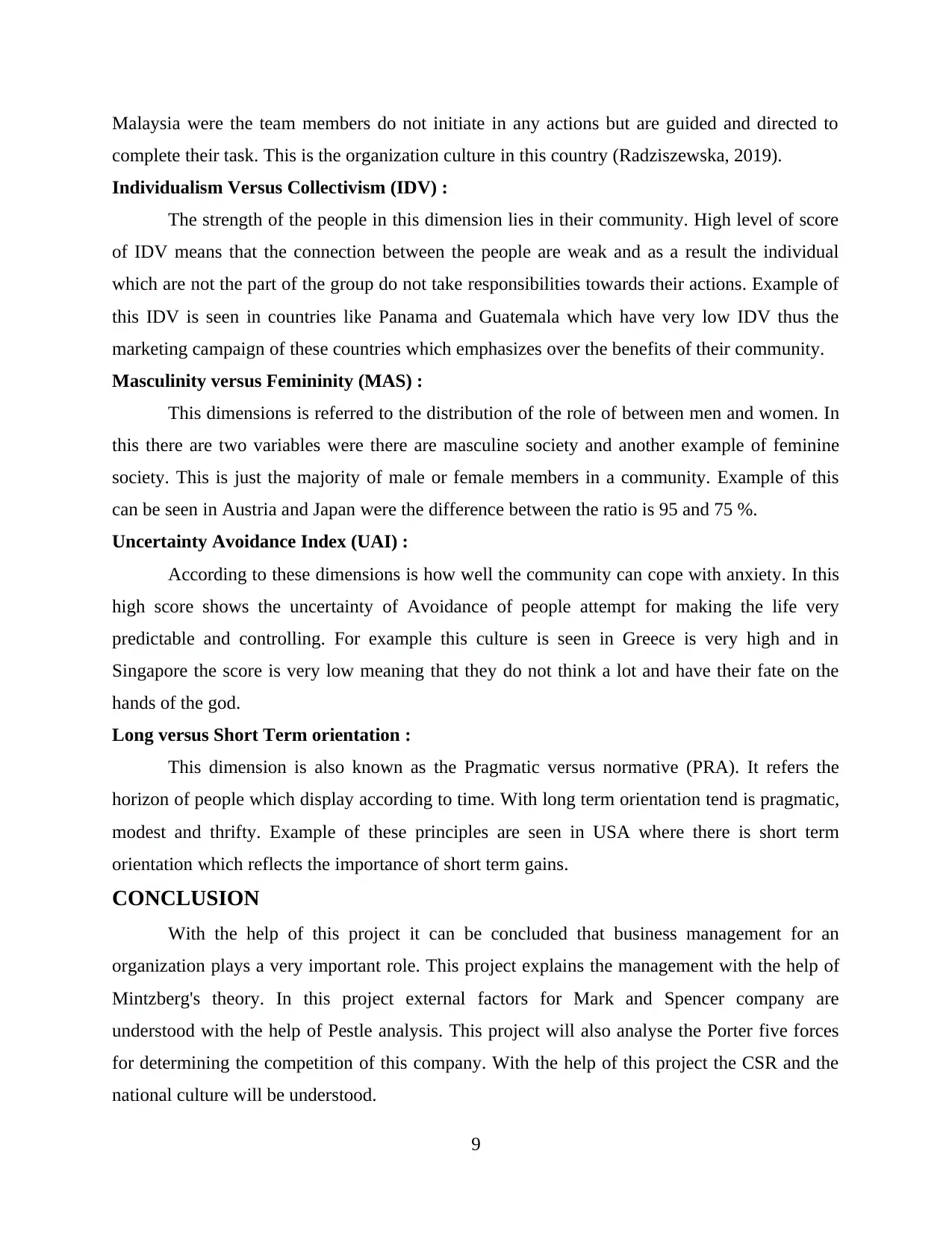
Malaysia were the team members do not initiate in any actions but are guided and directed to
complete their task. This is the organization culture in this country (Radziszewska, 2019).
Individualism Versus Collectivism (IDV) :
The strength of the people in this dimension lies in their community. High level of score
of IDV means that the connection between the people are weak and as a result the individual
which are not the part of the group do not take responsibilities towards their actions. Example of
this IDV is seen in countries like Panama and Guatemala which have very low IDV thus the
marketing campaign of these countries which emphasizes over the benefits of their community.
Masculinity versus Femininity (MAS) :
This dimensions is referred to the distribution of the role of between men and women. In
this there are two variables were there are masculine society and another example of feminine
society. This is just the majority of male or female members in a community. Example of this
can be seen in Austria and Japan were the difference between the ratio is 95 and 75 %.
Uncertainty Avoidance Index (UAI) :
According to these dimensions is how well the community can cope with anxiety. In this
high score shows the uncertainty of Avoidance of people attempt for making the life very
predictable and controlling. For example this culture is seen in Greece is very high and in
Singapore the score is very low meaning that they do not think a lot and have their fate on the
hands of the god.
Long versus Short Term orientation :
This dimension is also known as the Pragmatic versus normative (PRA). It refers the
horizon of people which display according to time. With long term orientation tend is pragmatic,
modest and thrifty. Example of these principles are seen in USA where there is short term
orientation which reflects the importance of short term gains.
CONCLUSION
With the help of this project it can be concluded that business management for an
organization plays a very important role. This project explains the management with the help of
Mintzberg's theory. In this project external factors for Mark and Spencer company are
understood with the help of Pestle analysis. This project will also analyse the Porter five forces
for determining the competition of this company. With the help of this project the CSR and the
national culture will be understood.
9
complete their task. This is the organization culture in this country (Radziszewska, 2019).
Individualism Versus Collectivism (IDV) :
The strength of the people in this dimension lies in their community. High level of score
of IDV means that the connection between the people are weak and as a result the individual
which are not the part of the group do not take responsibilities towards their actions. Example of
this IDV is seen in countries like Panama and Guatemala which have very low IDV thus the
marketing campaign of these countries which emphasizes over the benefits of their community.
Masculinity versus Femininity (MAS) :
This dimensions is referred to the distribution of the role of between men and women. In
this there are two variables were there are masculine society and another example of feminine
society. This is just the majority of male or female members in a community. Example of this
can be seen in Austria and Japan were the difference between the ratio is 95 and 75 %.
Uncertainty Avoidance Index (UAI) :
According to these dimensions is how well the community can cope with anxiety. In this
high score shows the uncertainty of Avoidance of people attempt for making the life very
predictable and controlling. For example this culture is seen in Greece is very high and in
Singapore the score is very low meaning that they do not think a lot and have their fate on the
hands of the god.
Long versus Short Term orientation :
This dimension is also known as the Pragmatic versus normative (PRA). It refers the
horizon of people which display according to time. With long term orientation tend is pragmatic,
modest and thrifty. Example of these principles are seen in USA where there is short term
orientation which reflects the importance of short term gains.
CONCLUSION
With the help of this project it can be concluded that business management for an
organization plays a very important role. This project explains the management with the help of
Mintzberg's theory. In this project external factors for Mark and Spencer company are
understood with the help of Pestle analysis. This project will also analyse the Porter five forces
for determining the competition of this company. With the help of this project the CSR and the
national culture will be understood.
9

REFERENCES
Books and Journals
Dmitrieva, D., Ilinova, A. and Kraslawski, A., 2017. Strategic management of the potash
industry in Russia. Resources Policy. 52. pp.81-89.
Henegama, H.P., 2021. Conceptual framework to explore the organizational conflicts in national
Universities in Sri Lanka and its effects on roles of administrators through their
personality traits.
Kang, B. and Sivadas, E., 2018. Corporate Social Responsibility and Word-of-Mouth
Intentions. Indian Journal of Marketing. 48(4). pp.7-20.
Lavigne, E., 2019. The collegial and managerial roles and qualifications of Canadian university
deans. Studies in Higher Education. 44(12). pp.2304-2317.
Matsuo, M., 2019. The unlearning of managerial skills: a qualitative study of executive
officers. European Management Review. 16(2). pp.303-315.
Orlov, A.K. and Chubarkina, I.Y., 2017. Blue ocean strategy application in the course of
planning and implementation of construction projects in the area of SMART housing and
social infrastructure. In MATEC Web of Conferences (Vol. 106, p. 08015). EDP Sciences.
Radziszewska, A., 2019. Cultural Determinants of E-commerce Website Quality
Assessment. Economic and Social Development: Book of Proceedings, pp.17-25.
Sangodema, R., 2018. The impact of corporate governance on organizational performance: The
case study of SOS Children‟ s Villages Zimbabwe (Doctoral dissertation, BUSE).
Symeonides, D., Loizia, P. and Zorpas, A.A., 2019. Tire waste management system in Cyprus in
the framework of circular economy strategy. Environmental Science and Pollution
Research. 26(35). pp.35445-35460.
Terrero-De La Rosa, A.,and et.al., 2017. Corporate social responsibility practices and programs
as a key strategic element in organizational performance. In Corporate Social
Responsibility and Corporate Governance. Emerald Publishing Limited.
Wolniak, R., 2017. The Corporate Social Responsibility practices in mining sector in Spain and
in Poland–similarities and differences. Zeszyty Naukowe. Organizacja i
Zarządzanie/Politechnika Śląska.
Online
Sadler, S., 2020. What are the signs and symptoms of corporate malpractice in your company?.
[Online] Available trough: <https://redwagonsolutions.com.au/what-are-the-signs-and-
symptoms-of-corporate-malpractice-in-your-company/>
Boddy, D., 2017.Management: An Introduction, 7th Edition.[Online] Available trough:
<https://www.pearson.com/uk/educators/higher-education-educators/program/Boddy-
Management-An-Introduction-7th-Edition/PGM1264842.html>
10
Books and Journals
Dmitrieva, D., Ilinova, A. and Kraslawski, A., 2017. Strategic management of the potash
industry in Russia. Resources Policy. 52. pp.81-89.
Henegama, H.P., 2021. Conceptual framework to explore the organizational conflicts in national
Universities in Sri Lanka and its effects on roles of administrators through their
personality traits.
Kang, B. and Sivadas, E., 2018. Corporate Social Responsibility and Word-of-Mouth
Intentions. Indian Journal of Marketing. 48(4). pp.7-20.
Lavigne, E., 2019. The collegial and managerial roles and qualifications of Canadian university
deans. Studies in Higher Education. 44(12). pp.2304-2317.
Matsuo, M., 2019. The unlearning of managerial skills: a qualitative study of executive
officers. European Management Review. 16(2). pp.303-315.
Orlov, A.K. and Chubarkina, I.Y., 2017. Blue ocean strategy application in the course of
planning and implementation of construction projects in the area of SMART housing and
social infrastructure. In MATEC Web of Conferences (Vol. 106, p. 08015). EDP Sciences.
Radziszewska, A., 2019. Cultural Determinants of E-commerce Website Quality
Assessment. Economic and Social Development: Book of Proceedings, pp.17-25.
Sangodema, R., 2018. The impact of corporate governance on organizational performance: The
case study of SOS Children‟ s Villages Zimbabwe (Doctoral dissertation, BUSE).
Symeonides, D., Loizia, P. and Zorpas, A.A., 2019. Tire waste management system in Cyprus in
the framework of circular economy strategy. Environmental Science and Pollution
Research. 26(35). pp.35445-35460.
Terrero-De La Rosa, A.,and et.al., 2017. Corporate social responsibility practices and programs
as a key strategic element in organizational performance. In Corporate Social
Responsibility and Corporate Governance. Emerald Publishing Limited.
Wolniak, R., 2017. The Corporate Social Responsibility practices in mining sector in Spain and
in Poland–similarities and differences. Zeszyty Naukowe. Organizacja i
Zarządzanie/Politechnika Śląska.
Online
Sadler, S., 2020. What are the signs and symptoms of corporate malpractice in your company?.
[Online] Available trough: <https://redwagonsolutions.com.au/what-are-the-signs-and-
symptoms-of-corporate-malpractice-in-your-company/>
Boddy, D., 2017.Management: An Introduction, 7th Edition.[Online] Available trough:
<https://www.pearson.com/uk/educators/higher-education-educators/program/Boddy-
Management-An-Introduction-7th-Edition/PGM1264842.html>
10
⊘ This is a preview!⊘
Do you want full access?
Subscribe today to unlock all pages.

Trusted by 1+ million students worldwide
1 out of 12
Related Documents
Your All-in-One AI-Powered Toolkit for Academic Success.
+13062052269
info@desklib.com
Available 24*7 on WhatsApp / Email
![[object Object]](/_next/static/media/star-bottom.7253800d.svg)
Unlock your academic potential
Copyright © 2020–2025 A2Z Services. All Rights Reserved. Developed and managed by ZUCOL.





